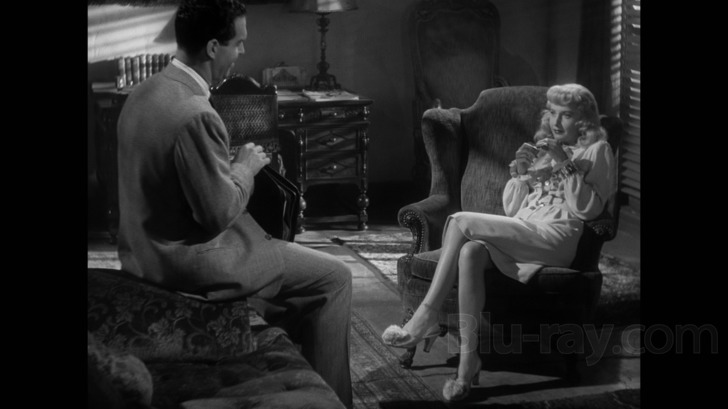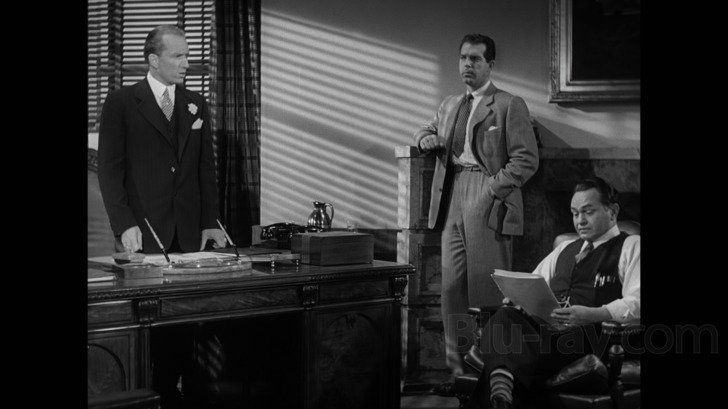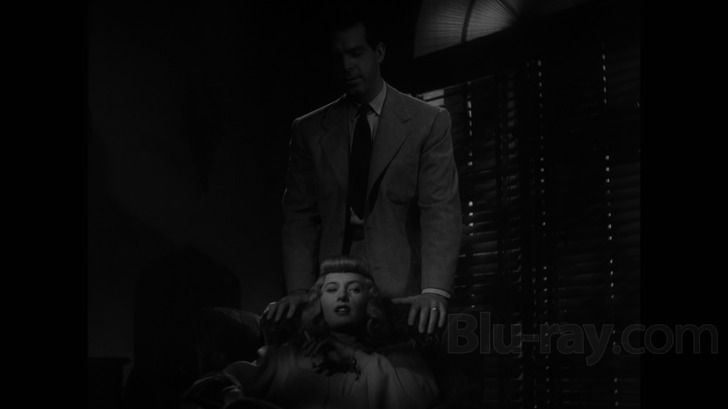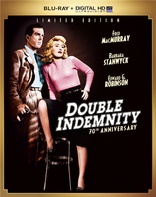Double Indemnity Blu-ray Movie
HomeDouble Indemnity Blu-ray Movie 
Limited Edition / Blu-ray + UV Digital CopyUniversal Studios | 1944 | 108 min | Not rated | Apr 15, 2014
Movie rating
8.8 | / 10 |
Blu-ray rating
| Users | 5.0 | |
| Reviewer | 4.5 | |
| Overall | 5.0 |
Overview
Double Indemnity (1944)
Los Angeles insurance representative lets an alluring housewife seduce him into a scheme of insurance fraud and murder.
Starring: Fred MacMurray, Barbara Stanwyck, Edward G. Robinson, Porter Hall, Jean HeatherDirector: Billy Wilder
| Drama | Uncertain |
| Film-Noir | Uncertain |
| Crime | Uncertain |
| Thriller | Uncertain |
Specifications
Video
Video codec: MPEG-4 AVC
Video resolution: 1080p
Aspect ratio: 1.35:1
Original aspect ratio: 1.37:1
Audio
English: DTS-HD Master Audio 2.0 Mono (48kHz, 24-bit)
Spanish: DTS 2.0 Mono
Subtitles
English SDH, French, Spanish
Discs
50GB Blu-ray Disc
Single disc (1 BD)
UV digital copy
Playback
Region free
Review
Rating summary
| Movie | 5.0 | |
| Video | 4.5 | |
| Audio | 4.0 | |
| Extras | 4.0 | |
| Overall | 4.5 |
Double Indemnity Blu-ray Movie Review
That Was No Lady; That Was My Femme Fatale
Reviewed by Michael Reuben April 13, 2014Director Billy Wilder said that he made Double Indemnity because the James M. Cain book he really wanted to film, The Postman Always Rings Twice, already belonged to Warner Brothers. Instead, Wilder adapted the novella that Cain published in serial form two years after Postman. Paramount hired crime novelist Raymond Chandler to co-write the screenplay and, as told many times in the years that followed, the writing partners clashed repeatedly—but they eventually turned out a screenplay so forceful that Cain became the rare author to express the view that Hollywood had improved on his book. Despite initial casting difficulties, because the material was pulpy and the main characters despicable, Wilder persuaded actors Barbara Stanwyck and Fred MacMurray to take the lead roles in what would become career-defining performances for both. He also persuaded Edward G. Robinson to accept third billing (for his usual salary), even though the actor was accustomed to starring roles. Robinson proceeded to steal every scene in which he appeared. In a career of memorable performances, it's one of his best. Double Indemnity is among those films that support the theory that Oscars are no badge of quality. Nominated for seven Academy Awards, including screenplay, director and best picture, the film went home empty-handed, shut out in most categories by another Paramount offering, Leo McCarey's Going My Way. Now, Going My Way is a perfectly fine film, but it's no Double Indemnity. Few films are. Double Indemnity was previously released on Blu-ray in a region B-locked special edition as part of the "Masters of Cinema" series from Eureka Entertainment. Universal is now issuing the film in region A with what appears to be a different video presentation and a similar but not identical set of extras.

Like The Postman Always Rings Twice, Double Indemnity takes the form of its lead character's confession. In Cain's novel, he writes it down, but Wilder and Chandler created the inspired device of having insurance salesman Walter Neff (MacMurray) dictate a memo to his colleague and friend, claims investigator Barton Keyes (Robinson). Obviously injured, Neff sits alone at night in his company's empty L.A. offices confessing his sins into a microphone. In words that neatly sum up the core of what would later be dubbed film noir, Neff says that he did it "for money and a woman—and I didn't get the money and I didn't get the woman." A routine call on a client named Dietrichson (Tom Powers) introduced Walter to the client's wife, Phyllis (Stanwyck). Before he knew what hit him, Walter found himself having an affair with the ambiguously attractive blonde, who poured out her marital woes. Almost as if he'd been waiting for the challenge, Walter agreed to help Phyllis murder her husband in such a way that she could collect on the accident policy they arranged for Dietrichson to acquire without his knowledge. The manner of death would trigger the policy's "double indemnity" clause, requiring the company to pay twice its stated value. Since Walter knows that his friend Keyes and his "little man" (as Keyes calls his intuition) will be all over the case looking for red flags, his planning is meticulous, and Wilder takes a Hitchcockian glee at drawing out the details so that the audience unwittingly sides with the murderers, becoming complicit in the successful planning and execution of their criminal scheme. (Lawrence Kasdan followed Wilder's template precisely almost forty years later in Body Heat, substituting inheritance for insurance.) At first they appear to be successful. Keyes's "little man" is initially quiet when Phyllis submits her claim. It's Walter who is changed by the experience. Immediately after killing Dietrichson, he somehow knows that he's doomed. Wilder manages the disintegration of Walter's scheme with the same precision as its execution. Keyes's "little man" wakes up, and the wily investigator begins digging. The dead man's daughter, Lola (Jean Heather), seeks out Walter with accusations against Phyllis and revelations that cause Walter to see his beloved in a whole new light. Lola's hot-tempered boyfriend, Nino Zachetti (Byron Barr), becomes a person of interest to both Keyes and Walter, though for entirely different reasons. And the relationship between Phyllis and Walter rapidly deteriorates into suspicion and mutual recrimination. In the end, all Walter can do is stagger into his office and record everything for the only person he knows whose integrity is beyond question. Almost every aspect of Double Indemnity has been analyzed and commented upon at length, but one facet that is often underappreciated is the literacy of its script. Wilder could tell a story visually as well as anyone else—he invented on the spot a wordless scene immediately following the murder that worked so well it has now become a cliche through imitation—but he also trusted the power of words. In Double Indemnity, he often has the actors speaking their dialogue at breakneck speed, almost as if they were playing a comedy, but the pace wouldn't work if the dialogue weren't so lucid and intelligent. A classic example is the scene in the office of insurance executive Edward S. Norton, Jr. (Richard Gaines), who summons Walter and Keyes to hear his theory that Mr. Dietrichson committed suicide, which wouldn't be covered under his policy. Keyes proceeds to destroy his boss's theory in a lengthy speech about actuarial tables—yes, actuarial tables. The phrase alone would make most people yawn, and today the speech would probably be cut from the script. But as written by Wilder (who got most of it from Cain) and forcefully delivered by Edward G. Robinson, the scene comes alive, because suddenly these things matter. If you set up the right dramatic context and choose the right words, even the driest subject becomes fascinating, and no one understood that better than Billy Wilder.
Double Indemnity Blu-ray Movie, Video Quality 

Wilder and cinematographer John Seitz (Sunset Boulevard) developed innovative techniques for lighting Double Indemnity that were widely copied: dark interiors, harsh and unflattering light, blinds throwing light and shadow at odd angles, strange shadows of indeterminate origin. The challenge for an accurate video reproduction of the filmed image is to recreate blacks with integrity, while delineating the appropriate shades of gray to reproduce fine detail and maintaining an appropriate level of contrast. Universal's catalog output has been wildly inconsistent, but their 1080p, AVC-encoded Blu-ray of Double Indemnity is one of their better efforts to date. In the dark interiors of the Dietrichson home or in Walter's apartment, and in the many night scenes, especially those involving the murder, the blacks are inky and deep, and the contrast isn't overstated. It's the right balance to allow detail to show through without being blown out by excessive whites. In better lit scenes like the insurance office, the shades of gray are finely layered for sense of depth and detail of office furnishings and staff at work. The fine detail of Phyllis Dietrichson's wardrobe, as well as of the blonde wig that proved so controversial, both at the time and over the years (Wilder first lamented it as a mistake, then claimed he'd done it on purpose), are sharply visible. The elements appear to be in very good shape, with no major damage. The film's grain pattern is fine and natural, without signs of filtering, sharpening or other untoward manipulation. The only real criticism is a recurrent flickering at both sides of the frame, which, though not serious, is noticeable. Several commentators noted the same phenomenon on the Eureka Masters of Cinema ("MOC") edition, which suggests that the issue may be inherent to the elements. The average bitrate of 32.98 Mbps provides more than sufficient bandwidth to handle Double Indemnity. (Note: Since I do not have either the MOC version of Double Indemnity or a region-free player, no attempt has been made to compare the two presentations.)
Double Indemnity Blu-ray Movie, Audio Quality 

Double Indemnity was released in mono, which is presented on Blu-ray in two-channel lossless DTS-HD MA. It's a well-mixed track with precisely placed sound effects. Listen, for example, to the sound of Walter Neff's dictaphone when he pauses; the old machines with their recording cylinders made an "idling" sound during pause, and it provides an undercurrent to Walter's thought process. Sounds of a moving train, automobiles, people in a grocery store and, in one famous scene, the distant orchestra at the Hollywood Bowl are all expertly blended into the mix. The all-important dialogue is always clear, and the revolutionary score by Miklós Rózsa, which his boss at Paramount hated but Wilder loved, supplies discordant and foreboding notes from the film's very opening.
Double Indemnity Blu-ray Movie, Special Features and Extras 

The disc-based extras have been ported over from Universal's 2006 "Legacy Series" two-disc special edition DVD of Double Indemnity. A featureless DVD was previously released by Image Entertainment in 1998.
- Introduction by Robert Osborne (480i; 1.33:1; 2:30): The Turner Classic Movies host provides an introduction similar to his short lead-ins on TCM.
- Shadows of Suspense (480i; 1.33:1; 37:56): This fine documentary provides both a history of the film's production and a critical evaluation through comments from numerous film critics, historians and directors.
- Double Indemnity (1973) TV Movie (480i; 1.33:1; 1:13:53): Featuring Richard Crenna as Walter Neff, Lee J. Cobb as Keyes and Samantha Eggar as Phyllis Dietrichson, this TV film aired on ABC. While it boasts a script by no less an author than Steven Bochco, and the cast does a creditable job, the remake provides a better commentary than a dozen treatises on just how remarkable Wilder's film really is. Watch it and see what gets lost in translation.
- Theatrical Trailer (480i; 1.33:1; 2:16): "Paramount's shocking . . . suspense-filled masterpiece of love . . . and murder!"
- Commentary with Film Historian Richard Schickel: Schickel alternates between scene-specific commentary and general observations about Wilder, his career and Double Indemnity in general. Schickel was part of the wide circle of friends and acquaintances that Wilder maintained in his later years, and he supplements his observations with personal anecdotes.
- Commentary with Film Historian/Screenwriter Lem Dobbs and Film Historian Nick Redman: Dobbs, who was introduced to Wilder as a boy by his parents, is the principal commentator, with Redman serving primarily as interviewer and prompter. Dobbs provides almost no scene-specific commentary, but instead ranges widely over the history of his friendship with Wilder, the genre of film noir in general and a general discussion of Double Indemnity.
- Memorabilia
- U.S. Theatrical Poster (postcard-size reproduction)
- 3 U.S. Lobby Cards (postcard-size reproductions)
- Alternate Ending Gas Chamber Still: As discussed in both commentaries, Wilder shot a different ending for the film but realized, after seeing the full assembly, that the ending did not work. He recut the film so that it ends as we now know it. Unfortunately, the original ending was not preserved, except for a few still images, such as this one.
Double Indemnity Blu-ray Movie, Overall Score and Recommendation 

As with Citizen Kane, the influence of Double Indemnity—in characterization, in performance, in visual style—has been so pervasive that viewers new to the film may wonder what the big deal is. But before Wilder took on the challenge, Cain's novella was considered unfilmable because of its degenerate and unredeemable lead characters. Today such figures are common, but it was Wilder who first showed Hollywood how to make audiences identify with them—and he did it at a time when the old Production Code put much greater restrictions on what he could show than does today's MPAA ratings system. He did it so well that Double Indemnity still plays effectively sixty years later. Highly recommended.
Other editions
Double Indemnity: Other Editions
Similar titles
Similar titles you might also like

The Killers
1946

In the Heat of the Night 4K
1967

Devil in a Blue Dress 4K
1995

Blood Simple 4K
1984

L.A. Confidential
1997

Whirlpool
Limited Edition to 3000
1950

The Long Goodbye
4K Restoration
1973

The Black Dahlia
2006

The Glass Key
1942

Swerve
2011

Kiss Me Deadly
1955

Klute
1971

State of Play
2009

Ministry of Fear
1944

Murder, My Sweet
Warner Archive Collection
1944

The Killing 4K
1956

High and Low 4K
天国と地獄 / Tengoku to jigoku
1963

Out of the Past
Warner Archive Collection
1947

Prisoners
2013

Fargo 4K
Collector's Edition
1996




